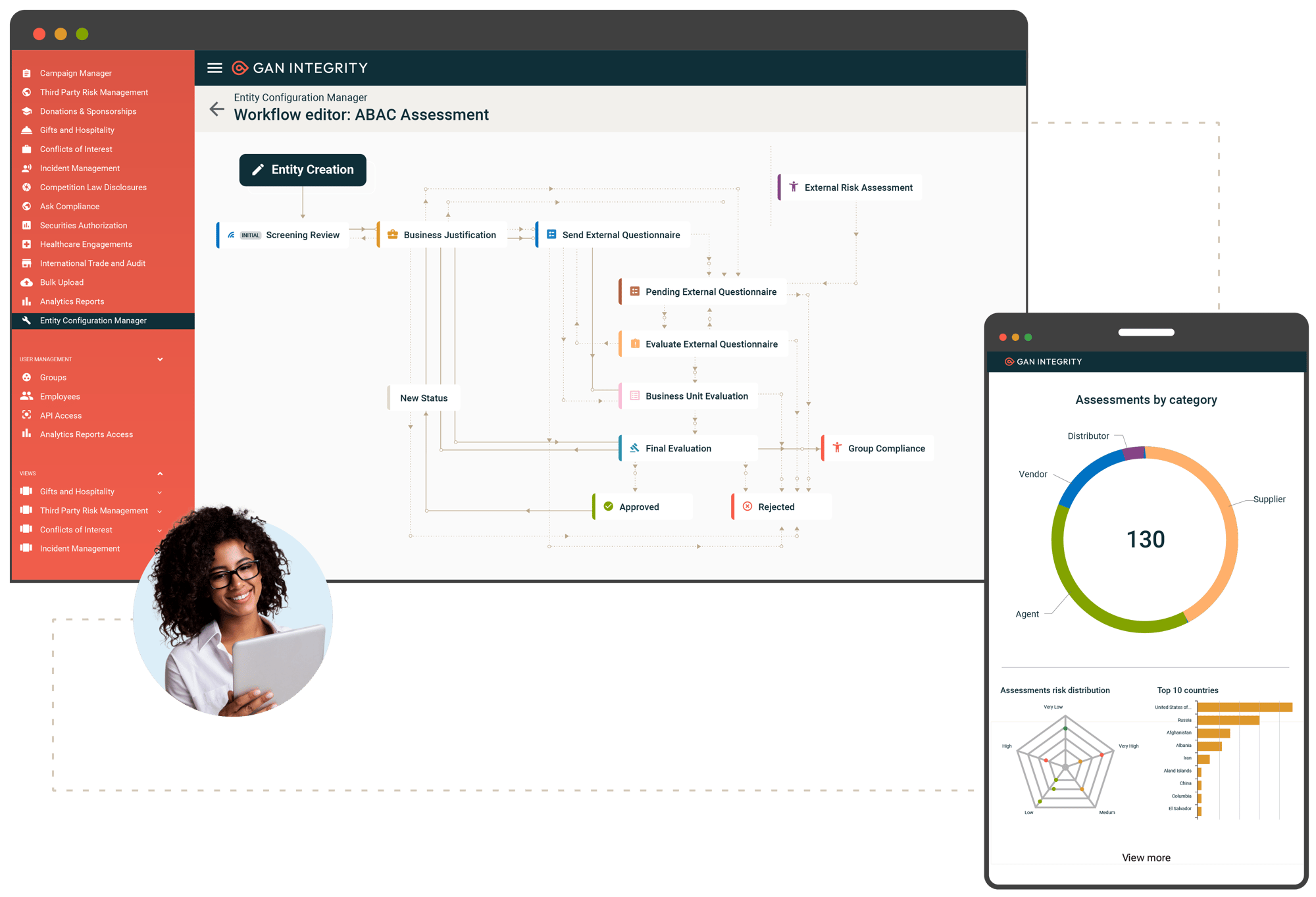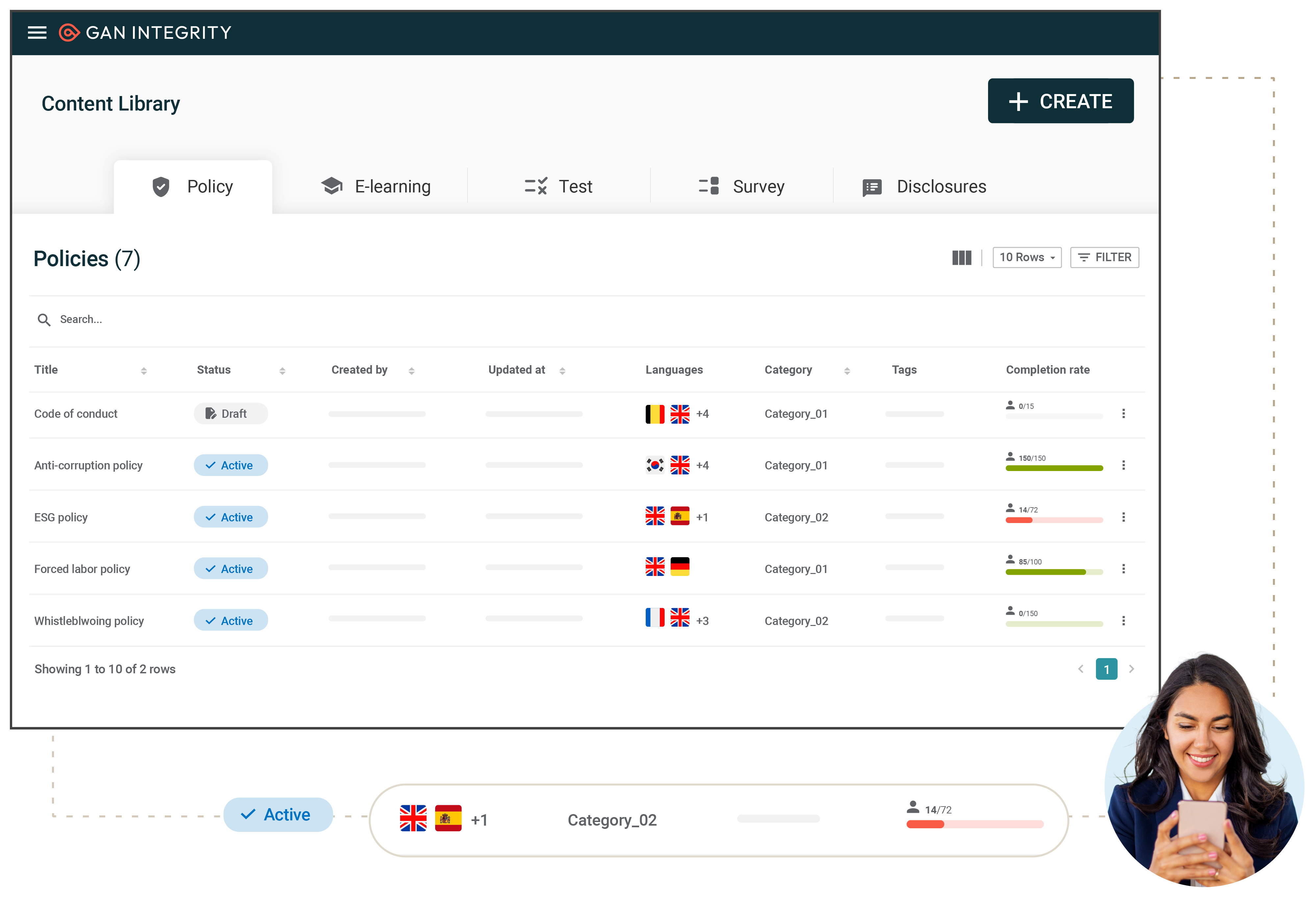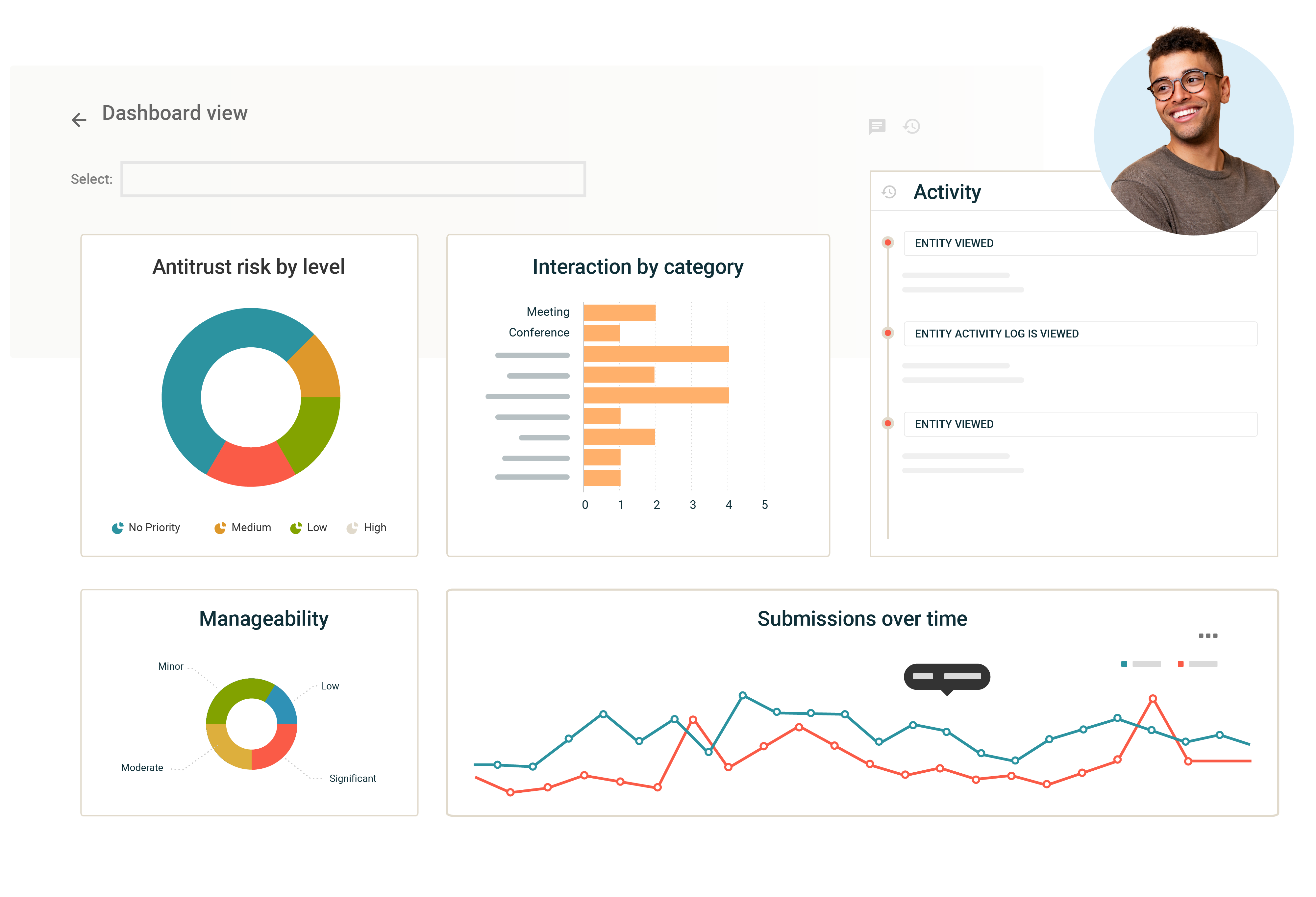Use Case
ABAC Compliance Solutions
Now there's a better way to manage your ABAC compliance. Implement Anti-Bribery and Corruption policies and training, capture conflicts of interest and disclosures, and screen and assess third-party risks — all in one place for a complete picture of risk.

Trusted by leading global companies
Key Pillars of an ABAC Program
Bribery and corruption can permeate all levels of an organization, especially in international businesses and those engaging with government officials. Comprehensive frameworks like the U.S. Foreign Corrupt Practices Act (FCPA), SAPIN II, and the U.K. Bribery Act provide robust guidelines for combating these issues globally. These regulations offer best practices for identifying, avoiding, reporting, and preventing corrupt activities, including:
Leadership and Commitment
Top leadership must set a zero-tolerance stance for bribery and corruption, actively support the ABAC program, and foster an ethical culture.
Risk Assessment
Regular, thorough risk assessments identify and evaluate bribery and corruption risks, allowing targeted mitigation strategies.
Policies and Procedures
Clear, comprehensive ABAC policies covering areas like gifts, hospitality, and third-party due diligence are essential.
Training and Communication
Ongoing training and clear communication ensure employees understand ABAC policies, the importance of compliance, and how to report issues.
Third-Party Management
Conduct risk-based due diligence and monitor third parties, including suppliers and agents, to ensure they adhere to ABAC standards.
Monitoring and Auditing
Regular monitoring and auditing to help track compliance, review controls, and detect issues.
Reporting and Investigation
A robust reporting mechanism, such as a whistleblower hotline, allows confidential reporting of suspected bribery and corruption.
Continuous Improvement
Regularly evaluate and update the ABAC program to adapt to regulatory changes and learn from past incidents.

Challenges building an ABAC program
Compliance teams are often caught in an unfair fight against bribery and corruption. Despite their hard work, they're often hampered by tight budgets and small teams, making it difficult to maintain effective compliance initiatives. The tangled web of organizational structures, siloed systems, and outdated processes only adds to the struggle, preventing clear visibility and consistency. On top of this, ever-changing regulations expand their responsibilities faster than their resources can match. Fighting corruption is important and compliance teams deserve better.
Building a better ABAC compliance program with GAN Integrity
Fortunately, with the right resources, technology, and support, you can build a world-class ABAC program. That’s why leading organizations around the world rely on GAN Integrity. We help you:
See everything
GAN Integrity provides a comprehensive view of all your ABAC risks.- Due diligence: Achieve visibility into all risks across your suppliers and third parties, identifying issues such as sanctions, enforcement actions, and employee disclosures.
- Data aggregation and reporting: Utilize flexible dashboards and comprehensive reports to get a consolidated view of your ABAC risk and compliance data.
- Disclosures: Engage employees with integrated compliance campaigns to capture and review conflicts of interest, and gift & entertainment disclosures, ensuring adherence to policies and regulations.


Adapt to anything
In a constantly changing regulatory landscape, GAN Integrity ensures your compliance program is agile and resilient, without the need for expensive IT projects.- Compliance gap analysis. Identify and bridge gaps between your current practices and emerging regulations to maintain continuous compliance.
- Third-party risk assessments: Implement a structured approach to evaluate your third parties, monitor risk changes, and adapt mitigation strategies as necessary.
- Policy management: Develop a comprehensive library of ABAC policies that are easily accessible and regularly updated for employees and third parties.
Get all the help you need
GAN Integrity offers comprehensive support and resources to ensure your success.- Expert support: Access our team of specialists for guidance on navigating complex regulations and developing effective ABAC strategies.
- Employee training & communication: Empower your employees with the knowledge and skills to make ethical decisions through engaging training programs and targeted communication campaigns.
- Streamlined workflow management: Efficiently manage approvals, revisions, and updates to your ABAC program through a centralized, configurable platform.

Our Solutions
Conflict of Interests Management
Manage employee conflicts of interest disclosures with an easy to use, configurable platform. Capabilities include:
- Reporting and Analytics: Role-based dashboards to identify areas of potential exposure with actions and remediation workflows to mitigate risks.
- Campaign management: Create conflicts of interest campaigns to inform and engage employees with training, policies and regular disclosure campaigns.
- Third-party risk integration: Track conflicts of interest disclosures against third parties and suppliers for a comprehensive view of risk.

Policy Management
Manage approvals, distribution, and attestation of policies, along with centralized portals for easy access to the latest policies and procedures. Capabilities include:- Regulatory change management: Identify policies that require updates and timely distribution to employees in response to regulatory changes.
- Automated workflow: Optimize the review and approval process for policies, operating procedures, and work instructions with automated workflows.
- Comprehensive reporting and documentation: Maintain a full audit trail and generate detailed reports to provide clear evidence of compliance to stakeholders and regulators.

Third-Party Risk Management
Manage risks associated with third parties and assess these against relevant laws and organizational standards. Capabilities include:- Lifecycle management: Automated workflows for onboarding, risk assessment, issue management, monitoring and off-boarding.
- Integrated due diligence: Initial and ongoing screening of third parties for sanctions, adverse media, forced labor, ESG and more.
- Reporting and analytics: Executive dashboards and reports: Consolidate third party data to identify risks and potential exposure to your organization.

Disclosure Management
Consolidate your disclosures for conflicts of interest, gifts, travel, entertainment, and political and charitable donations or contributions.- Policy management: Develop and enforce comprehensive disclosure policies. Educate and engage your workforce with targeted training and policy attestations.
- Flexible disclosure process: Simplify the submission of potential conflicts of interest with user-friendly forms, ensuring easy access for employees.
- Automated approvals and reviews: Enhance compliance with automated approval and review workflows. Quickly escalate notifications to relevant stakeholders to address potential risks.

Reporting and Documentation
See everything across your compliance program, and generate reports and dashboards to demonstrate compliance program effectiveness to stakeholders and evidence to regulators. Capabilities include:- Reporting and analytics: Executive, role-based dashboards to review the effectiveness of your compliance program initiatives.
- Evidence-based compliance: Maintain an auditable trail of all activity with the platform’s integrated and automated audit log.
- Compliance insights: See risk trends and patterns within your program, including third-party and supply chain risk, policies and disclosures.

The GAN Integrity Platform means all your compliance and ethics programs can be managed in one place - now that's better.
What Our Customers Say
The other piece that I really liked about GAN, related to the investigations and the case management, was that it was pretty simple and straightforward. For a company like ours, which is a manufacturing company, we’re averaging somewhere between 20 and 30 cases coming in a month. We don’t need a lot of complexity. We need it to be pretty simple, straightforward, and easy to use. And that was one of the things that really appealed to me about GAN.
Deborah Spanic
Chief Ethics and Compliance Officer for Clarios
GAN started out as only our high-risk transaction platform, then became our transaction, conflict and government interaction system. Now it’s just our Business Integrity platform
Jessie O’Neil
Business Integrity Global Lead, Barrick Gold
